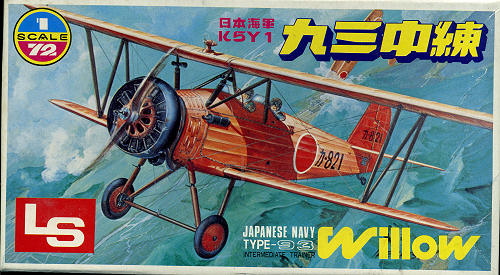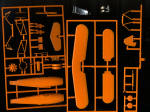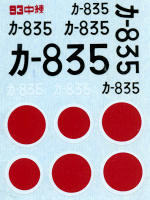
| KIT #: | A201 |
| PRICE: | $3.50 is what I paid for a 300 yen kit back in the mid 1980s. |
| DECALS: | One option |
| REVIEWER: | Scott Van Aken |
| NOTES: | LS is no more. Probably also released by Arii. |

| HISTORY |
If you just read the Valom preview, you can skip this part.
The Yokosuka K5Y was a two seat unequal-span biplane trainer aircraft (Allied codename: Willow) that served in the Imperial Japanese Navy during the World War II.
Due to its bright orange paint scheme (applied to all Japanese military trainers for visibility), it earned the nickname "aka-tombo", or "red dragonfly", after a type of insect common throughout Japan. The aircraft was based on the Yokosuka Type 91 Trainer, but stability problems led to a redesign by Kawanishi in 1933. It entered service in 1934 as a land-based K5Y1 with a fixed tail-skid landing gear, and remained in use throughout the war. Floatplane types K5Y2 and K5Y3 were also produced. After the initial 60 examples by Kawanishi, manufacture was continued by Watanabe (556 aircraft built), Mitsubishi (60), Hitachi (1,393), First Naval Air Technical Arsenal (75), Nakajima (24), Nippon (2,733), and Fuji (896), for a total of 5,770. These aircraft were the mainstay of Imperial Japanese Navy Air Service's flight training, and as intermediate trainers they were capable of performing demanding aerobatics.
| THE KIT |
 I
thought it might be interesting to look at the other 1/72 K5Y1 kit that has been
on the market. Many of you know that LS went out of business in the mid 1980s.
Its molds were picked up by Arii, and I'd be surprised if they did not alse
offer this aircraft under their markings as well. Arii is not well represented
in the US and it may be that they have also gone away.
I
thought it might be interesting to look at the other 1/72 K5Y1 kit that has been
on the market. Many of you know that LS went out of business in the mid 1980s.
Its molds were picked up by Arii, and I'd be surprised if they did not alse
offer this aircraft under their markings as well. Arii is not well represented
in the US and it may be that they have also gone away.
Anyway, LS wanted this one to be colorful, so they molded it in orange plastic, just to help with the painting. The surface detailing is quite good for a kit of this age. I can recall seeing it in Japanese hobby shops in the 1970s so it is a classic. Surface detailing is very good with somewhat understated fabric effect (no 'hills and valleys') and nicely done raised detail in the few places there are panel lines. This kit has slots in the wings for the one-piece strut assemblies, and that includes the inner cabanes on the upper wing. The upper wing is a single piece with the proper outer wing dihedral with the lower wing having tabs that fit into the fuselage. The cockpit is pretty basic with two generic looking seats and two crew members, both with sink marks in the stomach.
 A somewhat
generic but well done engine is provided with the cowl ring being two haves that
mate around it. The one piece horizontal stab has holes in the top through which
the fin/rudder is fit. Landing gear looks rugged enough, and there are hand
holds to place around the rear. The only option for this kit is a pair of what
look to be a machine gun that fits to the underside of the fuselage right behind
the engine. It is hard to be exact as the instructions are entirely in Japanese,
and that includes any color information, though it seems that what isn't orange
is black if you look at the box art. Instructions are well done and you should
have no trouble figuring out what goes where. No rigging diagram is provided so
one will have to use the box art for that. Despite their age, the decals look to
be still viable, especially as I had to open the sealed polybag to scan it. Unit
is unknown, but it doesn't matter. Being Japanese, it included a small tube of
glue that in no way would be enough to build the kit. I wonder if this is still
included in Japanese kits as I've not seen it in years.
A somewhat
generic but well done engine is provided with the cowl ring being two haves that
mate around it. The one piece horizontal stab has holes in the top through which
the fin/rudder is fit. Landing gear looks rugged enough, and there are hand
holds to place around the rear. The only option for this kit is a pair of what
look to be a machine gun that fits to the underside of the fuselage right behind
the engine. It is hard to be exact as the instructions are entirely in Japanese,
and that includes any color information, though it seems that what isn't orange
is black if you look at the box art. Instructions are well done and you should
have no trouble figuring out what goes where. No rigging diagram is provided so
one will have to use the box art for that. Despite their age, the decals look to
be still viable, especially as I had to open the sealed polybag to scan it. Unit
is unknown, but it doesn't matter. Being Japanese, it included a small tube of
glue that in no way would be enough to build the kit. I wonder if this is still
included in Japanese kits as I've not seen it in years.
| CONCLUSIONS |
Though not as detailed as the Valom kit, it is a viable alternative, assuming one can find it. It goes to show that even 30 plus years later, old kits are still quite buildable.
| REFERENCES |
http://en.wikipedia.org
There is also a FAOW edition that covers this aircraft and would make the best reference.
March 2009 If you would like your product reviewed fairly and quickly, please
contact
me or see other details in the
Note to
Contributors.